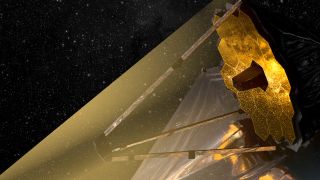James Webb Space Telescope recovers from 2nd instrument glitch
The famed telescope resumed full science operations on Monday (Jan. 30).

NASA's powerful $10 billion space telescope is firing on all cylinders again.
The James Webb Space Telescope (JWST or Webb) returned to full science operations on Monday (Jan. 30), recovering from a glitch that affected one of its instruments.
The Webb team conducted days of testing and evaluation after a "communications delay" on Jan. 15 caused issues with the telescope's Near Infrared Imager and Slitless Spectrograph (NIRISS) instrument, according to a Tuesday (Jan. 31) statement from NASA.
"Observations that were impacted by the pause in NIRISS operations will be rescheduled," said the agency in its brief statement, noting the instrument was recovered successfully on Friday (Jan. 27).
Related: James Webb Space Telescope's best images of all time (gallery)
NIRISS was provided by the Canadian Space Agency (CSA), so personnel from NASA and the CSA worked alongside one another for troubleshooting. The initial issue was a "communications delay within the instrument, causing its flight software to time out," according to a Jan. 24 statement from NASA.
NIRISS can normally work in four different modes, according to NASA. The instrument may be tasked with working as a camera when other JWST instruments are busy. Alternatively, NIRISS can look at light signatures of small exoplanet atmospheres, do high-contrast imaging or examine distant galaxies.
Get the Space.com Newsletter
Breaking space news, the latest updates on rocket launches, skywatching events and more!
Prior to the NIRISS glitch, an issue arose on another Webb instrument in August 2022: a grating wheel inside the observatory's Mid-Infrared Instrument (MIRI). The wheel is required for just one of MIRI's four observing modes, however, so the instrument continued observing during recovery operations. Work on recovering the affected mode, called the Medium Resolution Spectrometer, was completed in November.
In December, the JWST team also spent two weeks dealing with a glitch that kept putting the telescope into safe mode, making science observations difficult. A software glitch in the observatory's attitude control system was pinpointed as the issue, affecting the direction in which the telescope points. The observatory bounced back relatively quickly from that problem, resuming full science operations on Dec. 20.
Elizabeth Howell is the co-author of "Why Am I Taller?" (ECW Press, 2022; with Canadian astronaut Dave Williams), a book about space medicine. Follow her on Twitter @howellspace. Follow us on Twitter @Spacedotcom or Facebook.
Join our Space Forums to keep talking space on the latest missions, night sky and more! And if you have a news tip, correction or comment, let us know at: community@space.com.

Elizabeth Howell (she/her), Ph.D., is a staff writer in the spaceflight channel since 2022 covering diversity, education and gaming as well. She was contributing writer for Space.com for 10 years before joining full-time. Elizabeth's reporting includes multiple exclusives with the White House and Office of the Vice-President of the United States, an exclusive conversation with aspiring space tourist (and NSYNC bassist) Lance Bass, speaking several times with the International Space Station, witnessing five human spaceflight launches on two continents, flying parabolic, working inside a spacesuit, and participating in a simulated Mars mission. Her latest book, "Why Am I Taller?", is co-written with astronaut Dave Williams. Elizabeth holds a Ph.D. and M.Sc. in Space Studies from the University of North Dakota, a Bachelor of Journalism from Canada's Carleton University and a Bachelor of History from Canada's Athabasca University. Elizabeth is also a post-secondary instructor in communications and science at several institutions since 2015; her experience includes developing and teaching an astronomy course at Canada's Algonquin College (with Indigenous content as well) to more than 1,000 students since 2020. Elizabeth first got interested in space after watching the movie Apollo 13 in 1996, and still wants to be an astronaut someday. Mastodon: https://qoto.org/@howellspace
